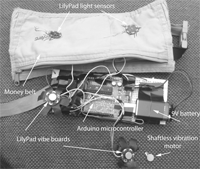Prototype 1: Vibrating Moneybelt
This prototype was built to test the suitability of Arduino LilyPad vibe boards for building vibrotactile interfaces. LilyPad vibe boards consist of a 10mm shaftless DC motor mounted on a thin printed circuit board that can be connected to a microcontroller using conductive thread and easily incorporated into clothing. In our simple device, if either of two LilyPad light sensors detects light levels above a hard-wired threshold value, then an Arduino Diecimila microcontroller switches on the vibe board that is associated with the light sensor. Inspired by Braitenberg’s classic Vehicles, this system can act as a light avoiding (vehicle 2a) or light seeking (2b) device, depending on whether each light sensor connects to the motor on the same or opposite side of the money belt.
The vibration was very clear through clothes and even though the vibe boards are relatively inexpensive components (under £10 each), we decided to buy the vibration motors directly (under £5 each) in order to save money and thereby enable us to potentially build large vibrotactile arrays. Also, it meant that we could prototype our own printed circuit boards, each containing a number of vibration motors.

